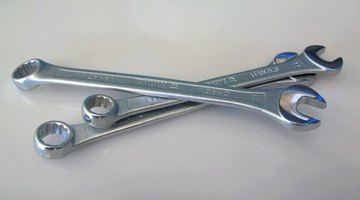The reduction ratio of a gear case describes the ratio between the revolutions per minute of the input shaft and the rpm of the output shaft, to either multiply torque, reduce speed, or both. A 3-to-1 reduction ratio gear case would thus convert 3,000rpm to 1,000rpm, while tripling the effective driving torque in foot-pounds. Reduction ratio is also a term used in metal forging and it describes the downsizing of ingredient amounts for smaller recipe batches in culinary circles. Since there are commonalities, all three are considered here.

Define the reduction gear set application. In this example, you are checking a gear case for a project. However, there are no markings on the outside to indicate the gear ratio. If you know the relationship between either input speed to output speed, or input force to output force, or the number of gear teeth on each gear, you may calculate the reduction ratio.
- The reduction ratio of a gear case describes the ratio between the revolutions per minute of the input shaft and the rpm of the output shaft, to either multiply torque, reduce speed, or both.
- If you know the relationship between either input speed to output speed, or input force to output force, or the number of gear teeth on each gear, you may calculate the reduction ratio.
Count the number of turns it takes the input shaft to turn the output shaft exactly one revolution. If it is easier to apply a force, use torque wrenches or torque meters to measure input and output torques.
Calculate the reduction ratio by dividing the number of input revolutions required to turn the output shaft once. If five revolutions are required, the reduction ratio is 5 to 1. If 2 1/3 revolutions are required, the reduction ratio is 2.33 to 1.
- Count the number of turns it takes the input shaft to turn the output shaft exactly one revolution.
- Calculate the reduction ratio by dividing the number of input revolutions required to turn the output shaft once.
Calculate the reduction ratio by dividing output torque by input torque. If 50 foot-pounds on the output results from 10 foot-pounds on the input, the reduction ratio is 5 to 1. This is similar to counting gear teeth. In that case, a 42-tooth gear driven by a 14-tooth gear calculates to 42/14, or a 3-to-1 reduction ratio.

Define the forging operation. In this case, a tool bar will be drop-forged from a width of 2.4 inches and a thickness of 1.0 inch to a final dimension of 2.0 inches inch wide and 0.8 inch thick. Calculate the reduction ratio by comparing cross-sectional areas.

Calculate cross-sectional area in before and after cases. Before forging the rod's cross-sectional area is 2.4 X 1.0 = 2.4 square inches. After forging it calculates 2.0 X 0.8 = 1.6 square inches.
Calculate the forging reduction ratio by dividing the cross-sectional area before forging with the cross-sectional area after forging. This works out to 2.4 square inches/1.6 square inches = 1.5 to 1 reduction ratio for the forging operation.
- Define the forging operation.
- This works out to 2.4 square inches/1.6 square inches = 1.5 to 1 reduction ratio for the forging operation.

Define the recipe-reduction application. This example uses a Margarita recipe that serves 32 people that is to be reduced to an amount sufficient to serve only 16. It requires 1,892ml of limeade concentrate, 8 cups of tequila, 2 3/4-cups of triple sec, and 11 tablespoons of confectioner's sugar. From this you can reduce the ratio from 32 to 16.
Calculate the reduction ratio by dividing 32 by 16. The quotient is 2.0, which means you will need to halve each ingredient for 16 people.
- Define the recipe-reduction application.
- The quotient is 2.0, which means you will need to halve each ingredient for 16 people.

Take half of each ingredient to maintain the proportion of the recipe. You will therefore need only 907gr of limeade; 4 cups of tequila; 1 3/8 cups of triple sec; and 5 1/2 tbsp of confectioner's sugar.
TIP
Converting to one set of smaller units such as ounces instead of both pounds and ounces greatly aids in dividing recipe amounts by the reduction ratio.
WARNING
Over-reducing drop forged tools can result in tool failure.
